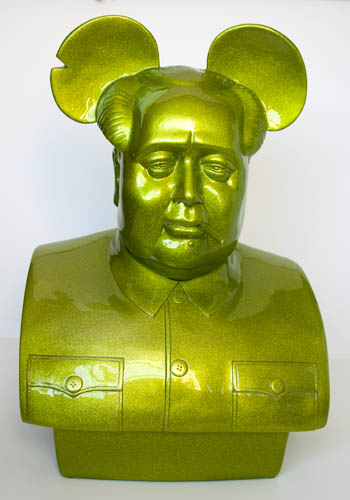"Here's the philosophy behind the Pop Shop: I wanted to continue the same sort of communication as with the subway drawings. I wanted to attract the same wide range of people and I wanted it to be a place where, yes, not only collectors could come, but also kids from the Bronx…this was still an art statement."- Keith Haring
An important aspect to keep in mind is that the artists who are creating art toys are doing so often as tangental to their main creative practice. There's a great interview that Paul Budnitz did with Kozik. This is how Kozik explains the factors that contribute to his art, and in particular his appropriation of Mao's image:
1. My love of and desire to make 'Pop Art'...what better than a large, shiny plastic object.
2. My fascination with Mao
3. My fascination with 'branding'
4. The utter oddness of the current '3rd road' approach in China
5. The ability to produce an exceedingly odd object of no value whatsoever, except it makes people go 'whoa... what the fuck?' ...and then want to own it.
6. My love of the utterly absurd.
Billy Shire Fine Arts
When asked about straddling the line between art and commercial products, Murakami said,
To Murakami, the gulf between his large scale sculpture and his art toys is not very big- he sees the connection as a fluid one."I don’t think of it as straddling. I think of it as changing the line. What I’ve been talking about for years is how in Japan, that line is less defined. Both by the culture and by the post-War economic situation. Japanese people accept that art and commerce will be blended; and in fact, they are surprised by the rigid and pretentious Western hierarchy of ‘high art.’ In the West, it certainly is dangerous to blend the two because people will throw all sorts of stones. But that's okay—I’m ready with my hard hat." (Wikipedia)
Referring to the difference between the consumer- made toys and his fine art, Murakami stated:
"Of course, the consumer group will be different, but it's the same aesthetic form in the end. And I would like it if these consumer groups were one and the same."He also acknowledges the political edge that his work has:
"While it is not meant as a blow at the art world per se, it is a political statement. Art does not have to be in a gallery. It does not have to cost thousands of dollars. It does not have to be elitist. It can be entertaining, and available." (from Plastic Culture by Woodrow Phoenix, 2006)
New York Times, from exhibition at Brooklyn Museum, 2008


ReplyDeleteIndia's cheap storage unitsfinest decorative arts for luxury home furniture and interiors. Our collection is custom created for you by our experts. we have a tendency to bring the world's best to our doorstep. welfurn is leading Interior design company that gives exquisite styles self storage units excellence in producing and Quality standards. will give door-step delivery and can complete the installation at your home.